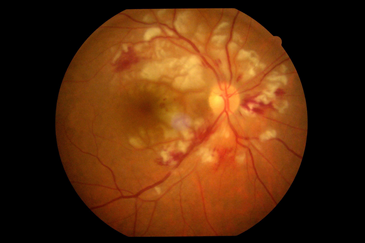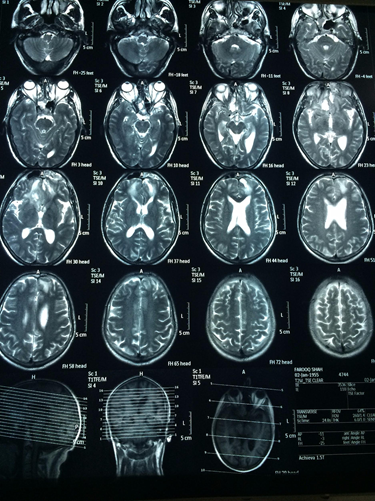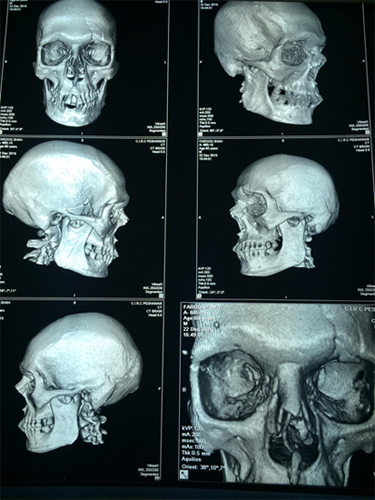Case Report
Volume 1 Issue 2 - 2017
Indirect Trauma Presenting as Post Traumatic Neuropathy Resulting in Decrease of Vision 4 Days Post Trauma: A Case Report
Department of Ophthalmology, Eye A Unit, Khyber Teaching Hospital, University Road Peshawar, Peshawar, Pakistan. 25000
*Corresponding Author: Syed Shahmeer Raza, Department of Ophthalmology, Eye A Unit, Khyber Teaching Hospital, University
Road Peshawar, Peshawar, Pakistan. 25000.
Received: May 06, 2017; Published: July 06, 2017
Abstract
Post Traumatic optic neuropathy occurs usually after a direct or indirect trauma leading to a visual pathway insult. This insult can
cause vision loss due to various trauma sequelae along the visual pathway; either pre-chiasmal or post-chiasmal lesions. This case
report documented a patient who complained of left sided decrease in vision 4 days post trauma. Patient was thoroughly investigated
with regular neurologist consultations. CT Scans showed multiple fractures in various regions of the skull vault and orbit, as well as
a bilateral frontal lobe hemorrhage with compression on the right optic nerve on an MRI. Patient was started on oral steroids and
referred to a neurologist who kept him under observation with conservative treatment. This report highlights the significance of
following up a trauma patient (especially of indirect trauma) and keeping them under strict observation with regular radiological
intervention as soon as possible. It is very rare that a patient can present with diminution in vision more than 24 hours after trauma
but it has never been reported that a patient presented with vision loss 4 days post trauma.
Keywords: Neuropathy; Hematoma; Contusion; Hemorrhagic & Traumatic
Introduction
The optic nerve is affected very easily due to trauma either direct or an indirect injury, usually occurring after road accidents or a blow
to the head during a fall which leads to loss in vision. Direct injury occurs after piercing injuries for example in orbital fractures. The most
common type of trauma is indirect the impact force which affects the optic nerve. Fronto-temporal injuries usually transmits forces of
compression to the orbital apex and optic canal. [1] Due to the specific anatomy involving the optic nerve with the Dura and periosteum,
compression of the nerve’s vessels can lead to a compartment syndrome which aggravates the nerve’s ischemia. [2] The aim of the study
is to establish that this is very rare and never been reported that a patient presented with loss of vision 4 days post trauma. Our case
highlights the significance of following up a trauma patient (especially of indirect trauma).
Case Report
The subject of this report is a 60 year old Asian, married, non-drinking, non-smoking man who was referred to the Ophthalmology
Department of Khyber Teaching Hospital by a neurologist for evaluation. He was in a road traffic accident (RTA) which caused him to fall
from his motorcycle and sustain injuries to the head in the left frontal region. 10 days Post RTA the patient presented to our unit with
complaint of left sided loss of vision for the past 6 days. He had been examined by the neurologist who had ordered a CT Brain, an OPG
and a 3D CT-scan of the head on the day of the accident. The scans confirmed multiple fractures of the orbit as well as of the anterior
cranial fossa. After presentation the Ophthalmology Department he was advised to get an MRI brain and orbits done to visualize the
optic canal and any bony fragments. He was also advised to get his visual fields done which showed right visual field defects.
When the patient presented to the neurologist he did not suffer any vision loss. The neurologist had done a full neurophysical examination
on presentation: his BP was 120/80 mm of hg, his GCS was 13/15. Dementia was not observed. He had no systemic disorders
like hypertension, diabetes, cardiovascular disease or chronic obstructive pulmonary disease.
Her best corrected visual acuity was 6/36 in the left eye and counting fingers in the right eye with no improvement on pinhole. Pupil
of the right eye was sluggish in reaction to light. A formal consent was obtained from the patient regarding reporting the case as a part
of medical literature.
An MRI of Brain and Orbits with contrast was ordered which showed post traumatic hemorrhagic contusion in frontal lobes with
hematoma in right frontal lobe compressing right optic nerve having high signals in right optic nerve. The 3D CT Face was done which
revealed blow out fracture right orbit with medial deviation of lamina papyracea was appreciated. Both the nasal and frontal bones
were fractured. Blood was present in the frontal sinus and multiple fractures of the floor of anterior cranial fossa were seen.
The patient was started on oral Deltacortril 5 mg, 13 Tablets tapered off in 15 days, reducing 3 tablets every 5 days and was required
to follow up with both Neurology and Ophthalmology Departments. At four Months follow up there was no focal or general neurological
deficits but the overall ocular defect had not improved considerably. The visual Field index had improved from 18% to 24% with a
permanent visual deficit. There was mild improvement in the Visual Field but no significant improvement in vision.
Figure 2: MRI of brain and orbits with contrast shows post traumatic
hemorrhagic contusion in frontal lobes with hematoma in right frontal lobe
compressing right optic nerve having high signals in right optic nerve.
Figure 3: The 3D CT Face was done which revealed blow out fracture right orbit with medial deviation
of lamina papyracea was appreciated. Both the nasal and frontal bones were fractured. Blood was present
in the frontal sinus and multiple fractures of the floor of anterior cranial fossa are seen.
Discussion
An indian case report reported that the loss of vision in a post trauma patient can occur due to a frontal contusion that leads an
optic nerve compression consequently because of gyrus rectus herniation into the suprasellar cistern. [3] The second national acute
spinal cord injury study (NASCIS 2) which was a multicentre, randomised, double-blind, placebo-controlled study of patients with
acute spinal cord injury was conducted. The result of this study highlighted a major motor and sensory progress with methylprednisolone
within 8 hours of the trauma as compared with placebo treated patients. [4]
Traditionally, traumatic optic neuropathy (TON) is divided into direct and indirect TON. In direct TON the insult to the optic nerve
is direct which leads to functional and structural loss in the integrity of the optic nerve. In indirect TON is the transmission of force
away from the optic nerve. [5,6]
Experiments suggest that the use of high dose steroid therapy in TON seems to have minimal effect. Rather, in cases of optic nerve
crush injuries it has harmful effects. Surprisingly no specific treatment is in fashion in cases of indirect TON. [7] Even in cases of direct
TON there has been no good evidence of treatment vs no treatment getting the desired results. [8]
This report highlights the significance of following up a trauma patient (especially of indirect trauma).
Conclusion
Further research is needed to support the evidence of treatment in direct/indirect TON. Our case highlights the significance of
following up a trauma patient and keeping them under strict observation with regular radiological intervention as soon as possible. It
is very rare that a patient can present with decrease in vision more than 24 hours after trauma but it has never been reported that a
patient presented with vision loss 4 days post trauma.
References
- Anderson RL., et al. “Optic nerve blindness following blunt forehead trauma”. Ophthalmology 89.5 (1982): 445–455.
- Walsh FB and Hoyt WF. “Clinical Neuro-ophthalmology, 3rd ed”. Williams and Wilkins: Baltimore (1969): 2380.
- Amit Agrawal., et al. “PRE-CHIASMATIC NERVE INJURY FOLLOWING FRONTAL CONTUSION”. European Journal of General Medicine 4.1 (2007): 44-46.
- Bracken MB., et al. “A randomized, controlled trial of methylprednisolone or naloxone in the treatment of acute spinal-cord injury. Results of the Second National Acute Spincal Cord Injury Study”. The New England Journal of Medicine 322.20 (1990): 1405–1411.
- Wolin MJ and Lavin PJ. “Spontaneous visual recovery from traumatic optic neuropathy after blunt head injury”. American Journal of Ophthalmology 109.4 (1990): 430–435.
- Steinsapir K and Goldberg R. “Traumatic optic neuropathy: a critical update”. Compr Ophthalmol Update 6.1 (2005): 11–21.
- Roberts I., et al. “Effect of intravenous corticosteroids on death within 14 days in 10008 adults with clinically significant head injury (MRC CRASH trial): randomized placebo controlled trial”. Lancet 364.9442 (2004): 1321-1328.
- Steinsapir KD. “Treatment of traumatic optic neuropathy with high dose corticosteroid”. Journal of Neuro-Ophthalmology 26.1 (2006): 65–67.
Citation:
Syed Shahmeer Raza., et al. “Indirect Trauma Presenting as Post Traumatic Neuropathy Resulting in Decrease of Vision 4
Days Post Trauma: A Case Report”. Ophthalmology and Vision Science 1.2 (2017): 85-88.
Copyright: © 2017 Syed Shahmeer Raza., et al. This is an open-access article distributed under the terms of the Creative Commons Attribution License, which permits unrestricted use, distribution, and reproduction in any medium, provided the original author and source are credited.






































 Scientia Ricerca is licensed and content of this site is available under a Creative Commons Attribution 4.0 International License.
Scientia Ricerca is licensed and content of this site is available under a Creative Commons Attribution 4.0 International License.